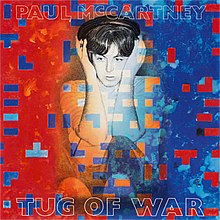Tug of War (Paul McCartney album)
| Tug of War | ||||
|---|---|---|---|---|
 |
||||
| Studio album by Paul McCartney | ||||
| Released | 26 April 1982 | |||
| Recorded | October 1980 – 8 December 1980, February 1981 – December 1981 | |||
| Genre | Rock | |||
| Length | 41:10 | |||
| Label |
Parlophone (UK) Columbia (US) |
|||
| Producer | George Martin | |||
| Paul McCartney chronology | ||||
|
||||
| Singles from Tug of War | ||||
|
||||
| Professional ratings | |
|---|---|
| Review scores | |
| Source | Rating |
| AllMusic | |
| Robert Christgau | B+ |
| Encyclopedia of Popular Music | |
| The Great Rock Discography | 5/10 |
| Pitchfork Media | 6.7/10 |
| PopMatters | |
| Q | |
| Rolling Stone | |
| The Rolling Stone Album Guide | |
| Uncut | 9/10 |
Tug of War is the third solo studio album by Paul McCartney, released in April 1982. It was McCartney's first album released after the dissolution of Wings in April, 1981 and McCartney's first album after the murder of former songwriting partner John Lennon. The album was produced by former Beatles producer George Martin and was a number 1 hit in numerous countries. It was hailed as a return-to-form for McCartney upon release. Its remastered deluxe edition received a nomination for Best Boxed or Special Limited Edition Package at the 2017 Grammy Awards.
Following the release of the solo album McCartney II, Wings regrouped in July and October 1980 to rehearse several songs which later appeared on Tug of War and Pipes of Peace. Feeling the need for direction, McCartney called upon his old producer, George Martin, to begin recording a song written for the animated Rupert Bear character (to which McCartney owned the rights), entitled "We All Stand Together", among others. The productive sessions continued until 9 December, the morning McCartney woke up to discover his old songwriting partner and fellow ex-Beatle, John Lennon, had been shot and killed the night before in New York City. Abandoning that day's session part-way through (where he and Denny Laine were recording future B-Side "Rainclouds"), both Martin and McCartney felt it was best to leave the project for the time being and start anew once they were ready.
In February 1981, two months after Lennon's death, Paul McCartney resumed his sessions, recording that month with Stevie Wonder, Stanley Clarke, Carl Perkins and Ringo Starr and laying down several songs in the process. The recordings were held at AIR Studios in Montserrat, in the Caribbean and lasted from 3 February to 2 March, ending with "Ebony and Ivory" and "What's That You're Doing," two songs featuring Stevie Wonder.10cc guitarist Eric Stewart also became a frequent collaborator of McCartney's during this era. Further sessions that summer were also undertaken at George Martin's AIR studios at Oxford Street, London – with the producer manning the controls and giving McCartney's music the benefit of 1980s technology. The sessions were so productive that several of its tracks would be held over for the next album, Pipes of Peace, which followed in 1983. The rest of 1981 would be spent in a quiet fashion, with McCartney and Martin touching up the album and perfecting it.
...
Wikipedia
